Sharing a bed: It's not all about sex.
News article
I remember in college I would get sick from Jonathan's waterbed. I swore that I was having seasickness and would sleep in the twin bed in the computer room. I told him he didn't have to come with, but he did, and the two of us smooshed together in there. This happened about a half dozen times before he decided to do a little experiment. He said it was impossible for me to get sea sick from a water bed and thought the whole thing was psychosomatic. I told him to shut up and get a real bed. (Not really - I used to be nice).
Anyhow, his experiment involved the two of us sleeping together in his waterbed - without having sex. Without the pressure of whether or not it was going to happen: without the emotions around it. Just us sleeping. I'll be darned if my sea sickness wasn't cured. At that time, sharing a bed meant sharing more. Now it's more about stealing the covers!
Created as a daily update of my time volunteering in Belfast, Northern Ireland with pages from other trips to Ireland and England. Now a journal of my travels through life.
Saturday, September 30, 2006
Saturday, September 09, 2006
Out with the old...
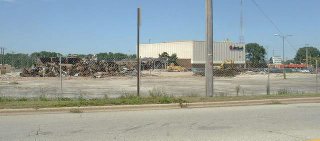
In my birthday post, I mentioned the mall I was working at ten years before. The destruction of the mall has begun, as evidenced in the photo above.
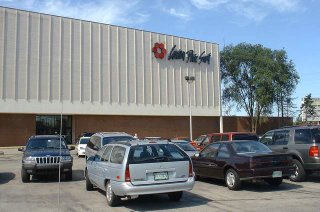
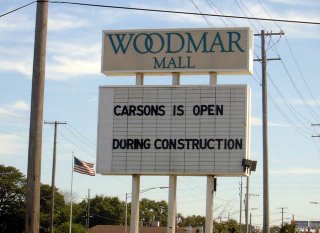
The anchor store, Carson's is still open for business.
The other side of the mall wasn't torn down at the time of the photos, and I tried to get a peek in and capture what was left of the hangout of my youth.
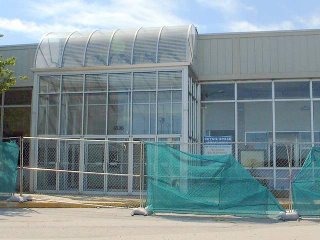
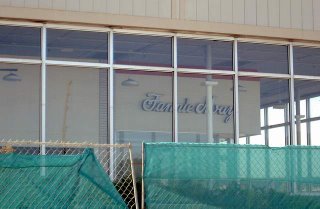
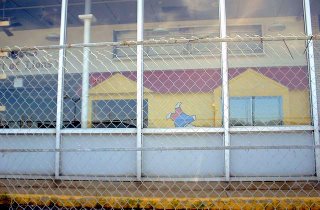
Of course, near the end, it was merely a shadow of its former self. At the time of closing, there were only five stores other than Carson's. It started a swift plunge down in 1996 when Walgreens closed. Walgreens was removing all of its mall store and going toward free standing buildings to further expand its twenty four hour/seven day a week store base. Instead of replacing it with a comparable store, it was rented to "Bargain Books", which didn't even bother to make the store look different. It used the racks and cases Walgreens left behind. It was a disaster. First, one restaurant in the food court left and was never replaced. Then another. Then big chain stores like KayBee toys and Lerner New York left. They were replaced with cheap dollar stores of the "fell off the truck" variety. Like dominoes, they all fell down.
A WalMart was built right behind Woodmar, and a grocery store right next to that. A Home Depot just down the block opened earlier this year. Woodmar Mall is set to be replaced by some sort of strip mall sort of thing. Sure, it's only a mall, a building; but to me, it was a memento of my coming of age. When we moved here when I was 11, I would walk to the mall with my friends, no parents. That was where we hung out, took photos in the photo booth, met boys, got to buy what we wanted and learned how to be the people we would become. Its destruction is a painful reminder, that like Woodmar, my childhood is now just a memory.
Roots and Weeds

I have been working on my family tree for some time now. I always knew I was from Irish descent, and had bits and pieces of possible English heritage, but never delved much further. While living in England, whenever I had contact from people from Northern Ireland, I felt a certain connection. I felt like the Northern Irish were "my people". Of course, then I moved to Northern Ireland for a little while, and I was hoping to make my own roots there, or more accurately, a return to them. At that time, though, I had no proof, only a feeling and some unfounded family history.
Through genealogical websites like ancestry.com, genealogy.com, and various rootsweb sites (which is part of ancestry.com), there are vast amounts of resources available with the click of a mouse, if you have the money to pay for it. Ancestry.com memberships can be as high as $40 a month with a minimum requirement of a year. Rootsweb sites are generally free, but are very specific. For example, you can't just go to the site and plug in a name and see what comes up. You have to know where to look and for whom you're searching. I have learned a lot through the rootsweb site for the county of Alabama from which many of my most recent ancestors descend.
But what about when you don't really know where they are from?
Ancestry.com has a feature called "One World Tree" (owt). People submit their own family trees and compare notes. Eventually one of your branches will link to someone elses, and if you are a paid member, you can add that other person's entire tree to your orchard, in effect making one world tree.
I recently discovered that my local library has ancestry.com library edition. I can access this plethora of information with just my library card. My tree has grown by many branches since this discovery. At first, I started out by looking at direct records, such as census data and birth and death indexes. That worked up until the early nineteenth century. The U.S. didn't even become the U.S. until 1776, and they didn't get around to censuses until the mid 1800s. I thought I was going to go back a few generations and get to the Irish and English stuff, but I was starting to get the idea my ancestors came over on the Mayflower! So where was I to get my info now?
One World Tree. I could put in the name of my ancestor and there could be up to a hundred people who had that name in their tree. Since most of these people had been working on this far longer than me, they had done extensively more research and had sources like church records, family bibles, and random books and paper records in the town where this ancestor lived.
One complaint often voiced about One World Tree is the amount of mis-information. Once someone submits a tree, it is there for the world to see regardless of its accuracy. What often happens is if someone is the only person with info on a particular family line, other people will copy that info. Now suddenly there are a dozen trees with the same info. You see this number of corroborating evidence and think, "well, it must be true if that many people have it", but really it all comes from one uninformed source.
For example, I was so happy to finally find proof of that emotional kinship I felt with Northern Ireland when I located one world tree entries of my ancestors from Ulster. I added the info to my tree, then sent a request to a volunteer in Northern Ireland via the site Random Acts of Genealogical Kindness (raogk.org). We went over a few of the details and she said that she had never heard of the place where one of my ancestors was reported to have been born. The place was, "Gatsyde Allancy, Albra, Ireland". She noted that although some places had various names and spellings, there was nothing even close to this in Northern Ireland. I started my own search on google, where a half dozen or so entries came up, all referring to the birthplace of this same person. Google asked me if I meant Gatsyde Allancy Alba Ireland, and when I tried that, nothing came up. Puzzled, I broke the phrase down into smaller pieces and found that this place was not in Ireland at all, but in Scotland. Alba was an old name for Scotland. So those half dozen entries that came up on my google search, which, by the way, were on sites other than ancestry, all had the exact same misinformation.
I don't think one can blame the uninformed source, or even the genealogists who source that source. Just be aware that this resource is a lead and not absolute. More importantly, source your information - even if you did get it from John Smith on One World Tree who got it from Sue Jones who got it from Mary Brown. Then, at least whoever views that information will know where it came from. Even when you have official records, there can be errors. Whether it is clerical, intentional or just the census taken misunderstanding what your ancestors with those really think southern accents were saying, mistakes happen. With this, as in many other things in life, you have to take the good with the bad, sort the roots from the weeds and make your own decisions.
Note: photo above from message board posting and originates from a Japanese website where a rabbit owner discovered his pet's talent for being able to balance things on his head.
Subscribe to:
Posts (Atom)